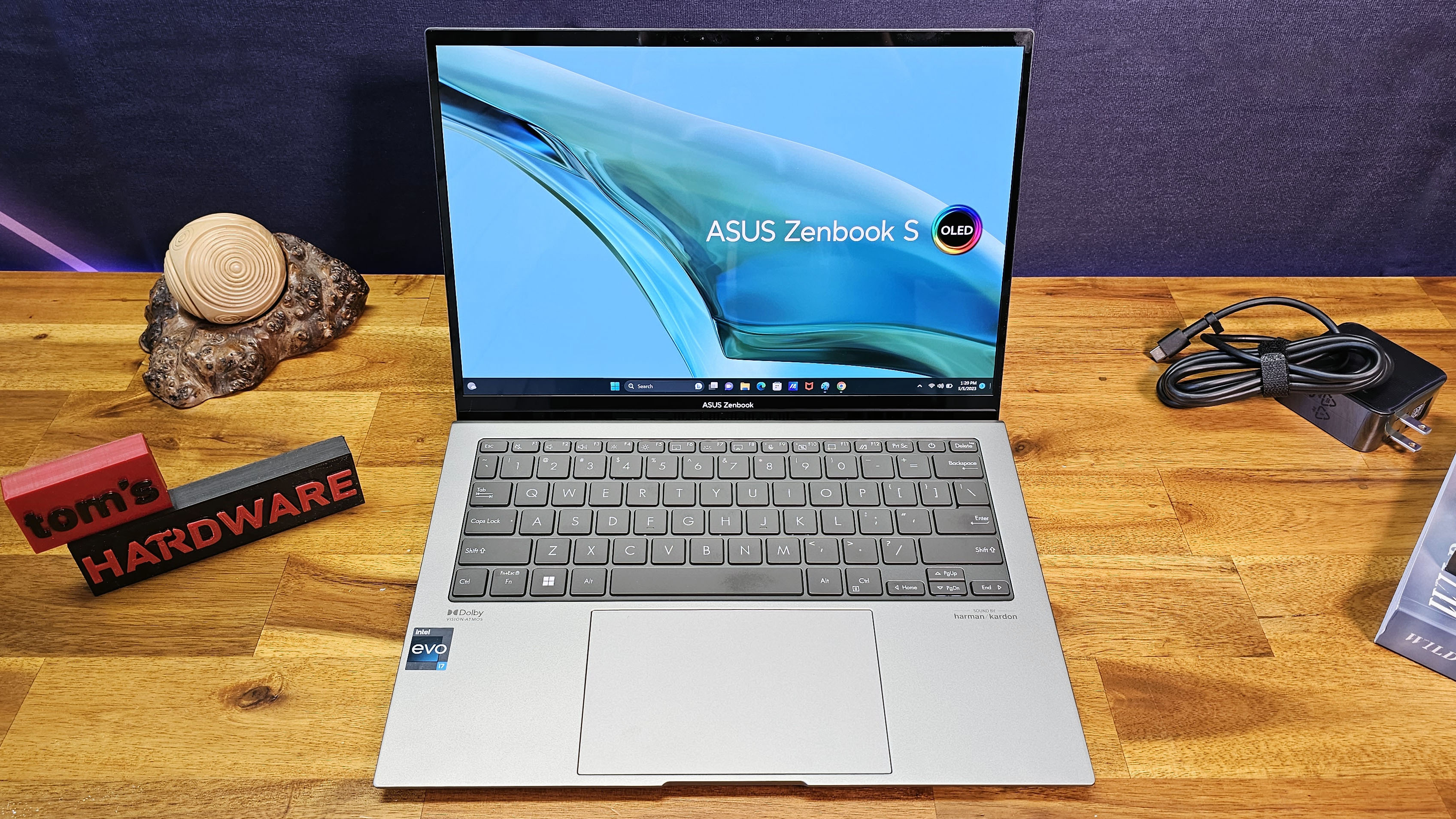
For several years now, Asus' Zenbook ultraportable line has largely been a more affordable but capable alternative to some of the best ultraportables, like Dell's XPS 13 or HP's Dragonflys. In recent years, Asus has aggressively shifted to OLED screens, which helped the line stand out a bit more. But with its 2023 model, the Zenbook S 13 OLED (UX5304), Asus seems to be attempting to go from an also-ran to a leader in terms of design, while also maintaining its value angle – at least for those who can make use of its ample specs.
With an Intel 13th Gen Core i7-1355U processor, 1TB SSD and an impressive 32GB of RAM as standard, along with a 13.3-inch 2880 x 1800 OLED display, the Zenbook S 13 brings impressive specs for its $1,399 price. And while that's more than the $1,099 starting price of last year's model, it's also 0.23 pounds lighter (2.2 pounds) and thinner (0.43 inches) than its predecessor while delivering both Thunderbolt 4/USB-C ports and a still-handy USB-A port. While its battery life wasn't better than the MacBook Air or the most recent XPS 13, the Zenbook did last over 10 hours in our testing, which is solid for something this thin and light.
But while all of that sounds (and indeed is) quite impressive, there are some downsides to the Zenbook S 13. For starters, the laptop ships with some nagging bloatware (McAfee is the main culprit). And performance in CPU-heavy long-term tasks definitely suffers as a result of the limited cooling afforded by the laptop's stylishly slim design. So it's better suited to light and bursty computing tasks.
It's also important to note we had a major issue with our first review unit. Near the end of our 30-minute Cinebench stress test, the display suddenly went permanently black, refusing to display anything, while every other aspect of the laptop functioned normally. We were worried that heat may have caused this issue, but Asus sent us another unit, which we put through the same stress test – three times in a row just to be sure – and the display on that unit continued to function perfectly. Considering no one else who reviewed this laptop seems to have suffered a screen failure, and we couldn't find any user reviews complaining of the same problem, it seems likely that our first unit was just faulty.
Design of the Asus Zenbook S 13
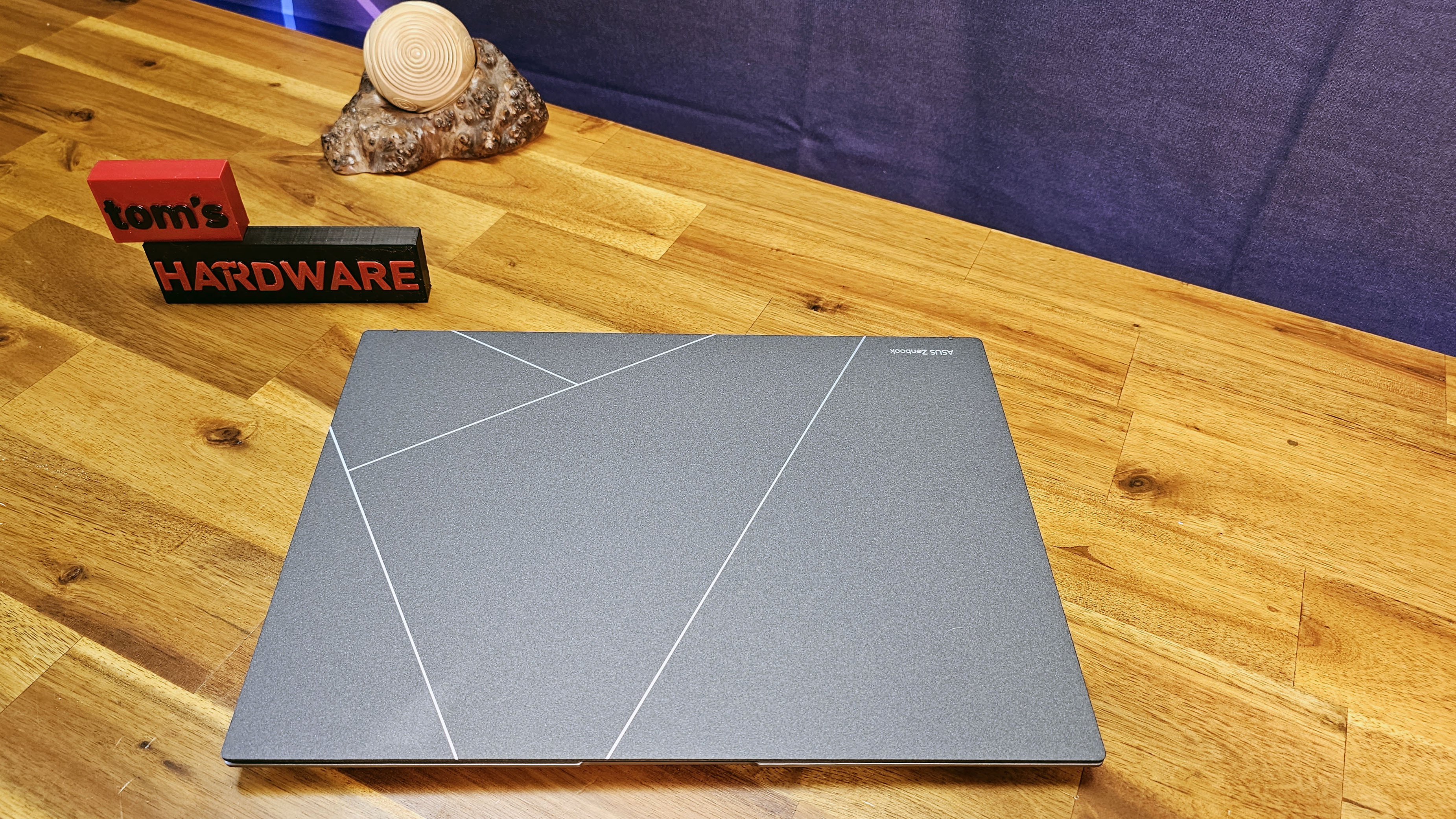
Asus has gone all-out with the design of its latest Zenbook, producing one of the edgiest and prettiest ultrabooks I've seen in years. The company is also keen to call out its use of recycled metals and plastics in the Zenbook S 13. But while those moves are important, it's the striking silver lines running through the "plasma ceramic aluminum" lid that grabbed me first. And when you open that lid, you're met with a gorgeous 2880 x 1800-resolution OLED screen rated at 550 nits. As we'll see later in testing, the display is also great at displaying vivid colors.
The lid material feels like a mix between smooth stone and metal, and it resists fingerprints and smudges better than most metal-clad laptops.
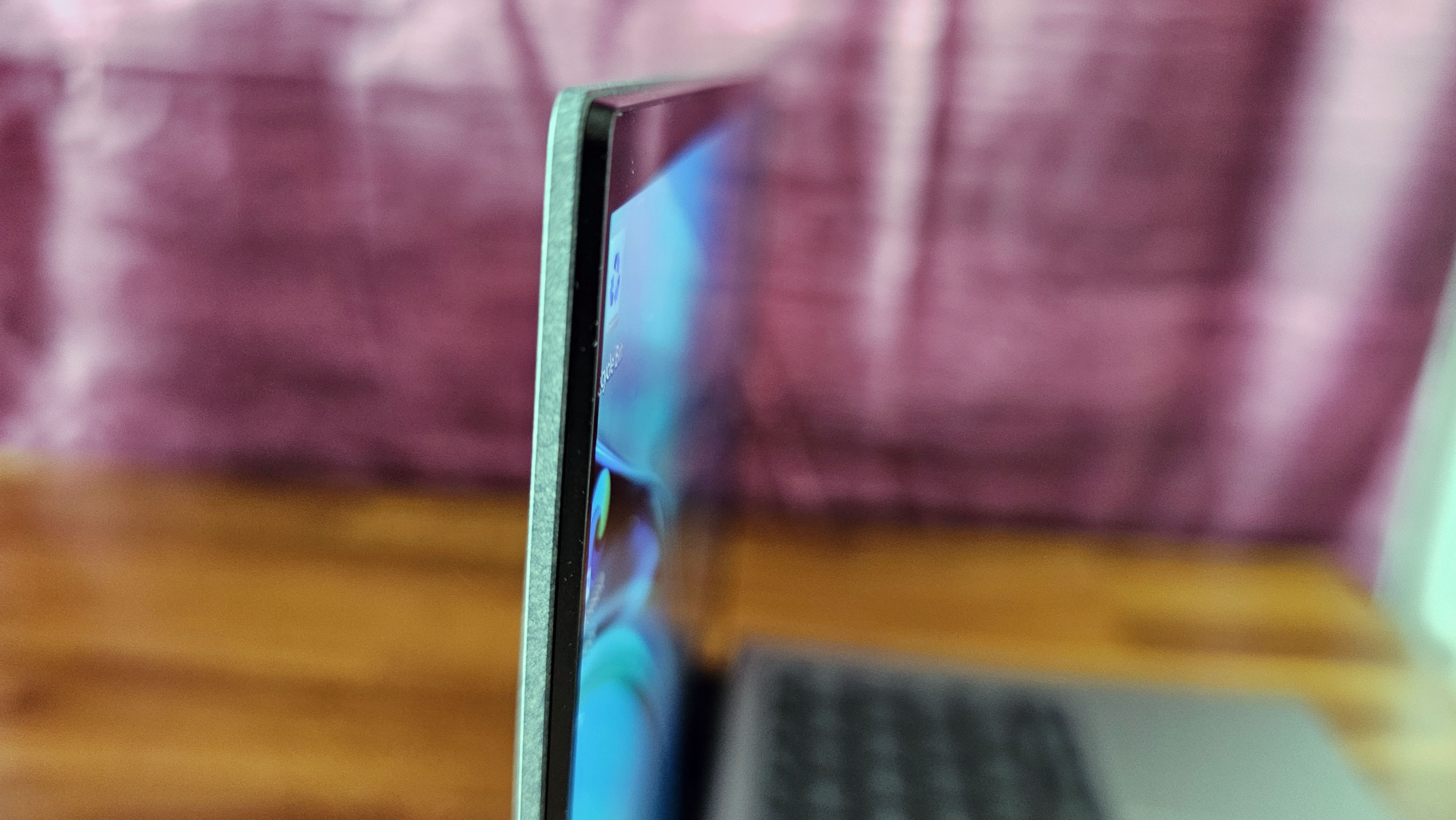
The company says that CNC machining into the lid material has allowed for a thinner lid overall. I measured it at around 3mm thick, and I was surprised at how little flex there was considering the lid looks on close inspection like a piece of metal with a sheet of glass attached to it.
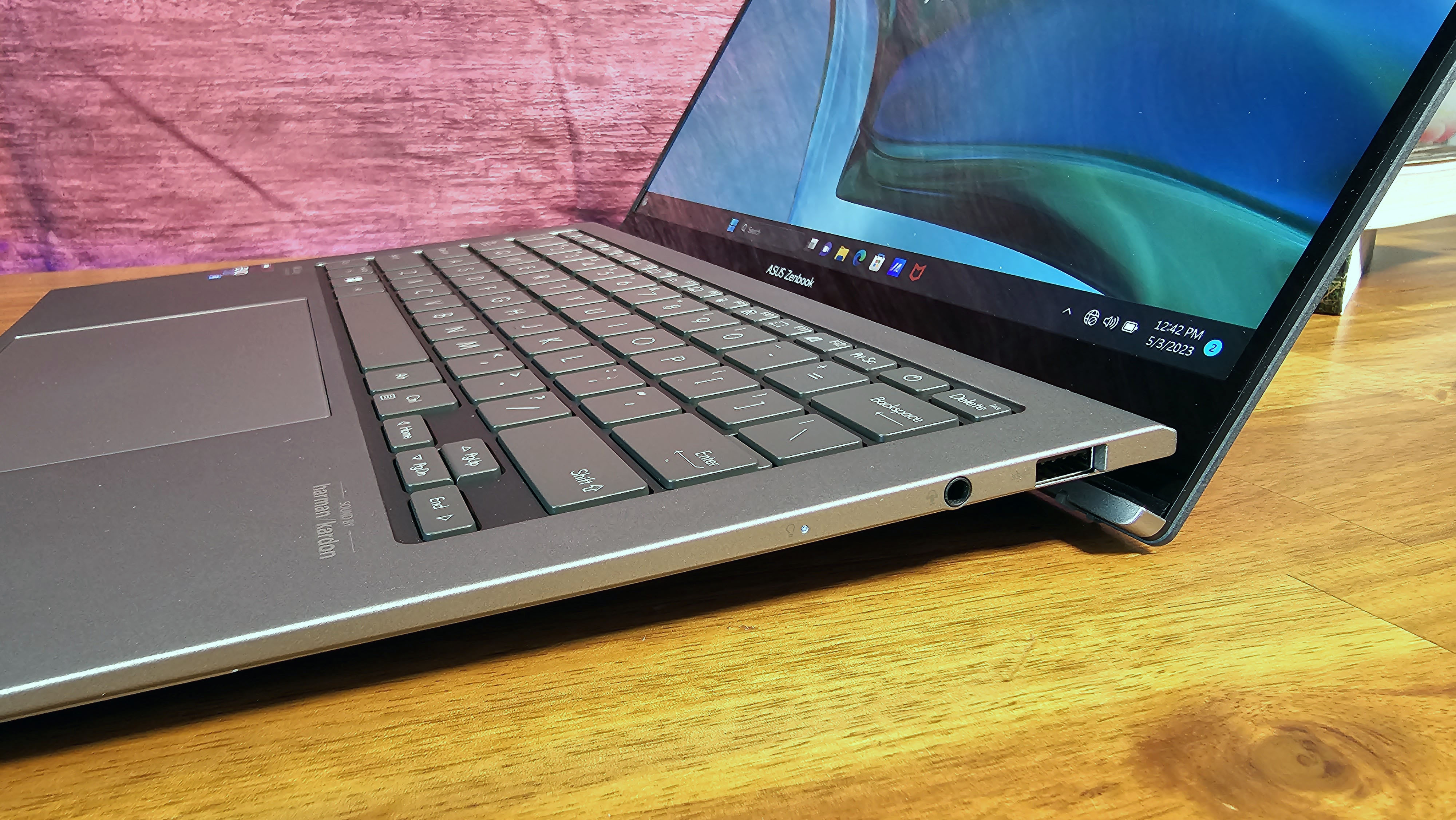
And I generally don't place too much importance on absolute thinness. But it's hard not to be impressed by the laptop's 0.42-inch profile – especially when you realize Asus managed to include a USB-A port on the right edge, alongside an audio combo jack. On the other side is a full-size HDMI port, along with a pair of Thunderbolt 4 / USB-C ports. Any company that claims there isn't space for full-size ports or an audio jack in a slim laptop is officially on notice.
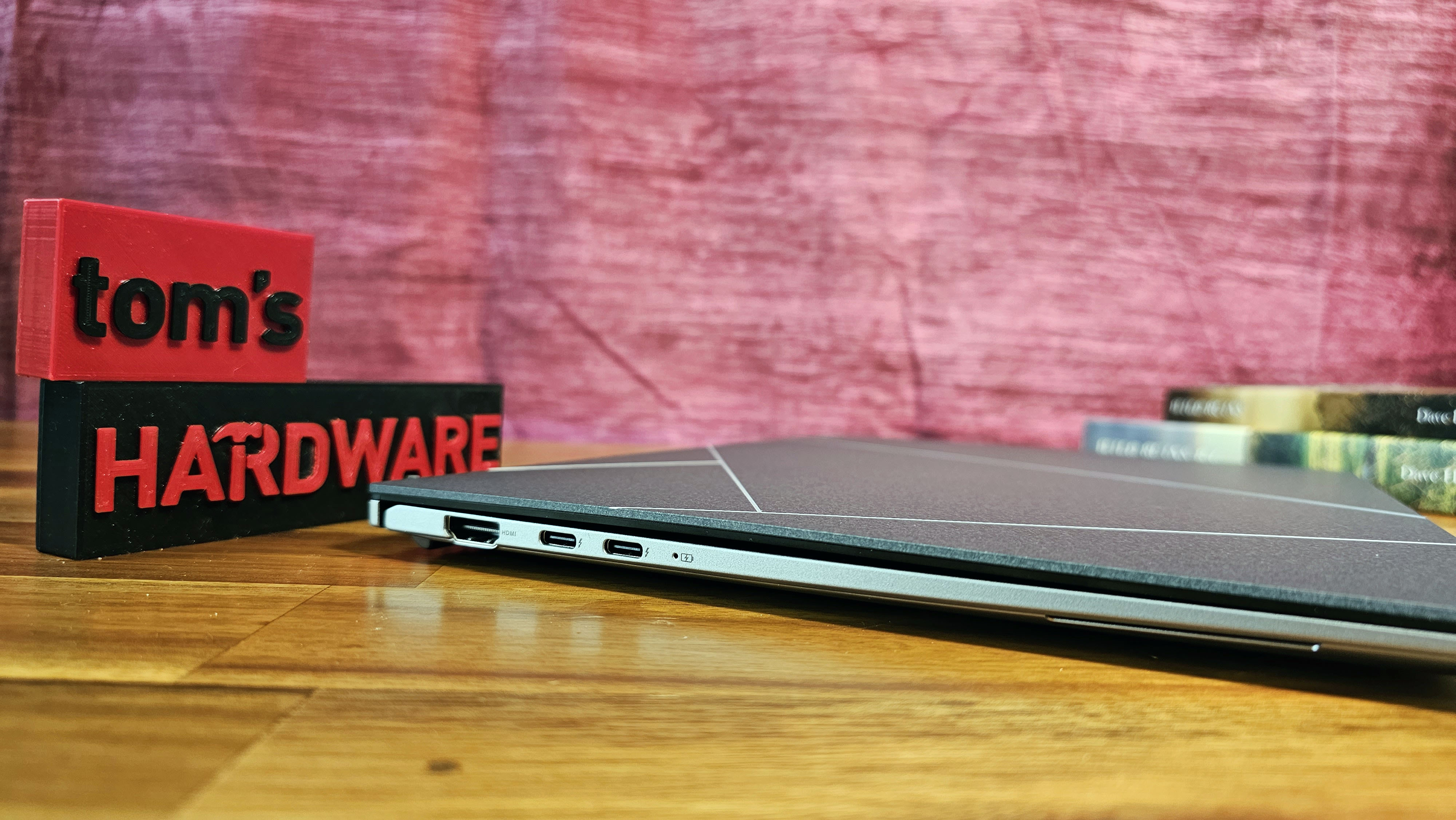
Surprisingly, the Zenbook S 13's hinge also opens to nearly 180 degrees, which wasn't something I was expecting. As with previous models, the hinge also lifts the rear of the laptop off the surface, helping improve airflow.
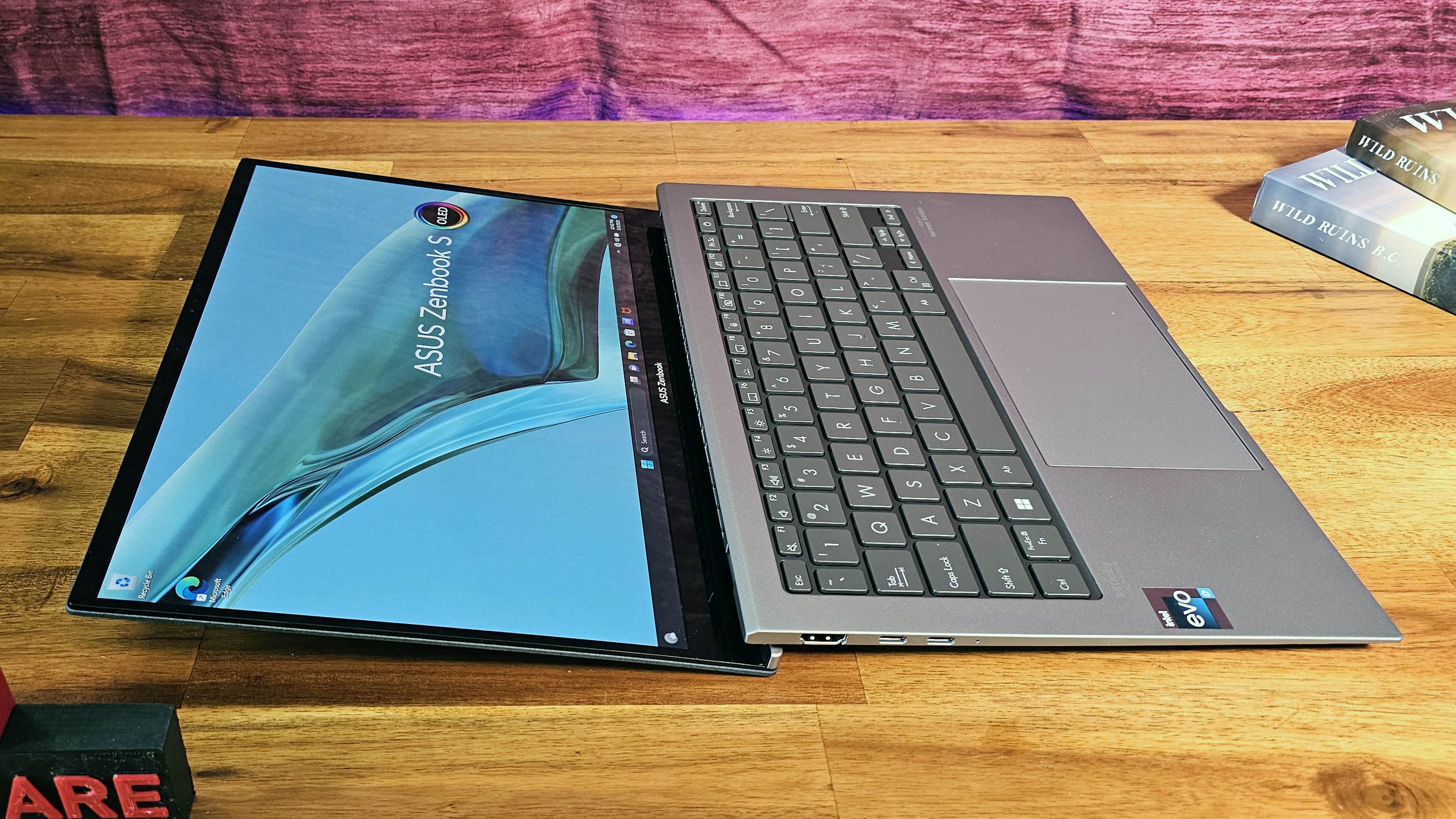
All that said, Asus certainly ins't alone in the extremely thin and light laptop space. HP's Elite Dragonfly G3 weighs the same 2.2 pounds and is slightly thicker at 0.64 inches. The latest XPS 13 is slightly heavier at 2.59 pounds, but is thinner than the Dragonfly (and slightly thicker than the Asus) at 0.55 inches. Apple's MacBook Air continues to be the institutional benchmark that slim laptops are measured against, and at 0.44 inches thick, the latest M2 MacBook Air is basically the same thickness as the Zenbook, but at 2.7 pounds, it's noticeably heavier.
Keep in mind, though, that all of the above ultralight competition is more expensive than the Zenbook S 13's $1,399, and most of it much more expensive when similarly equipped with the 32GB of RAM and 1TB SSD that comes standard in the sole U.S. configuration of the Zenbook. Apple's Air doesn't even offer a 32GB option, but a 24GB/1TB configuration sells for $2,099.
Asus Zenbook S 13 Specifications
Productivity Performance of the Asus Zenbook S 13
Looking at specs alone, the Zenbook S 13 seems quite competitive, with an Intel Core i7-1355U processor, a 1TB PCIe Gen4 SSD and an impressive 32GB of RAM as standard. (For some odd reason, the Canadian version of the Zenbook only gets 16GB of RAM.) But at just 0.43 inches thick, I had a strong suspicion that limited space for cooling hardware would lead to lesser performance.
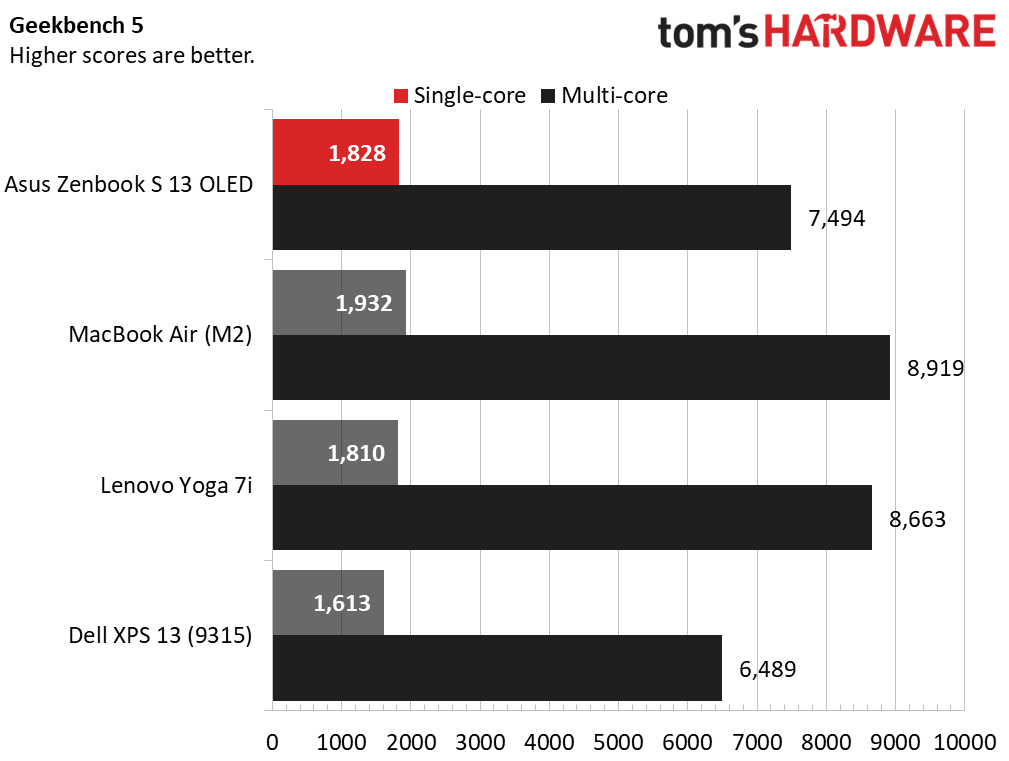
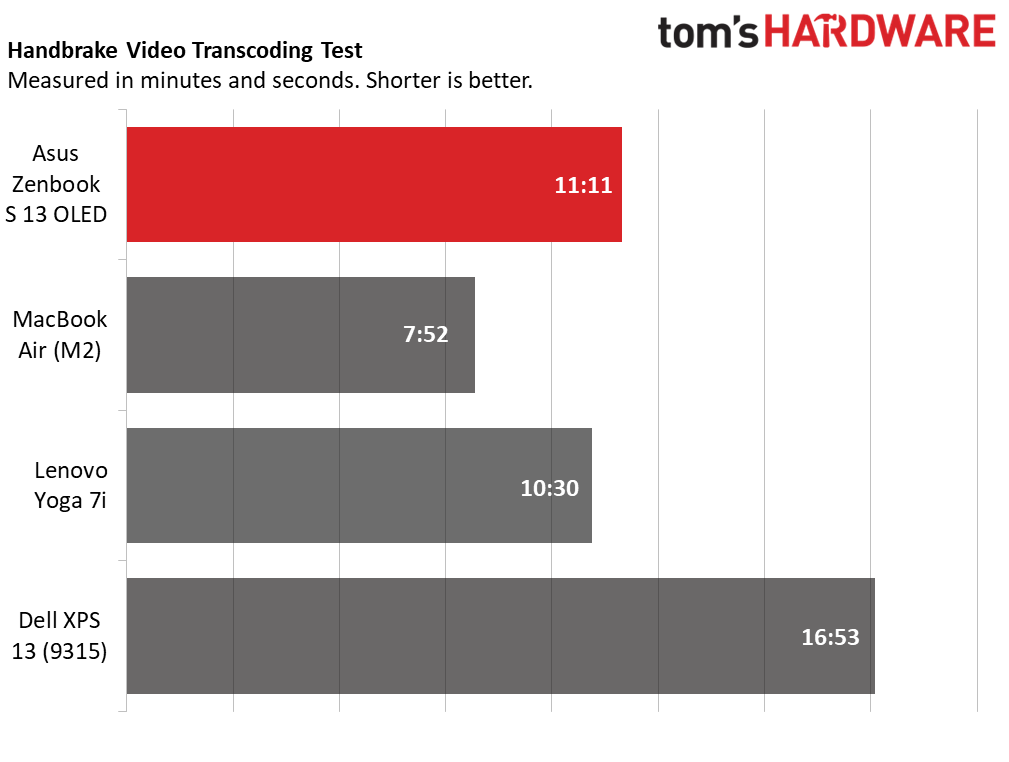
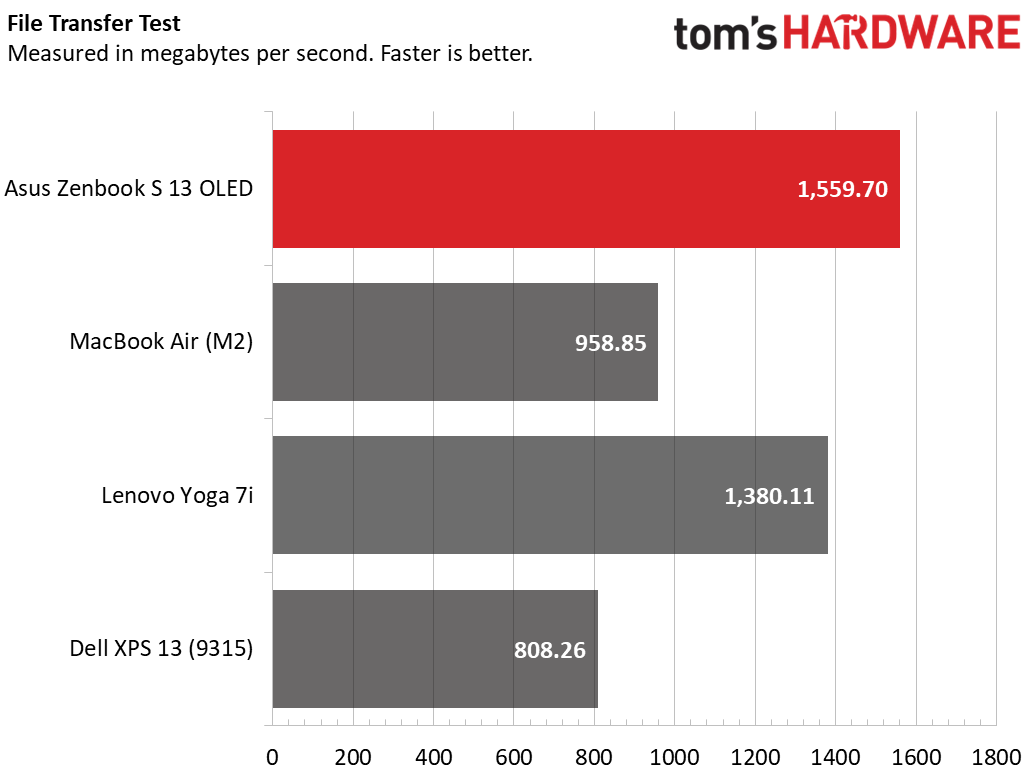
On Geekbench 5, things didn't look too bad for the Zenbook. Its single-core score of 1,828 was actually better than the Lenovo Yoga 7i, which shares the same processor. But the Zenbook's multi-core score of 7,494 lagged behind the Yoga's 8,663. And the latest MacBook Air led the pack on both fronts, with a single-core score of 1,932 and a multi-core result of 8,919.
Things looked worse for the Zenbook on our Handbrake video transcoding test. It took Asus' laptop 11 minutes and 11 seconds to transcode our 4K test video to 1080p. The Air again floated to victory here, taking just 7:52 to finish the same test. And the last-generation Dell XPS 13 was far behind at 16:53. But the Lenovo Yoga 7i with the same CPU as the Zenbook finished in 10:30, 41 seconds faster than the Asus.
The Zenbook managed to come out ahead in our 25GB file transfer test, moving our batch of test files at an impressive rate of 1,5560 MBps. The Yoga 7i wasn't too far behind at 1,380 MBps, but both the XPS 13 and Apple's Air were much slower, slipping below 1000 MBps.
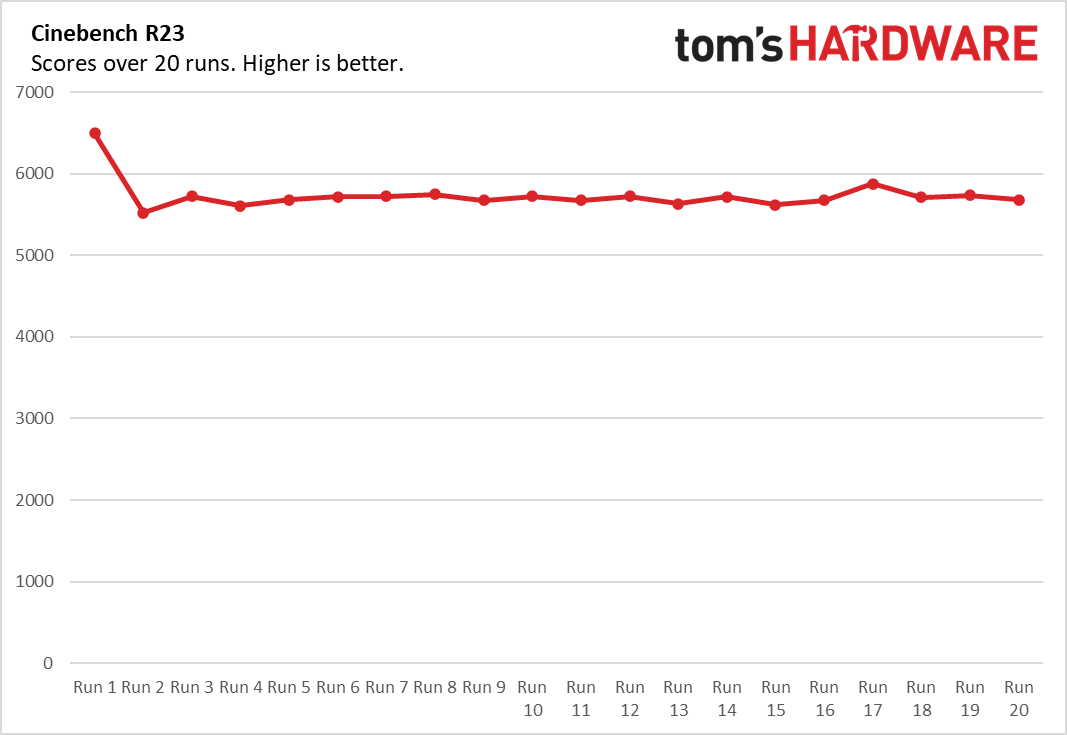
To really stress the Zenbook S 13, we put it through 20 runs of Cinebench R23, and here is where we truly saw the downsides of the laptop's slim design – in multiple ways. The Zenbook started at a high of 6,497, dropped to 5,520 on run two, then stayed at or above 5,600 for the rest of its runs. The fans were steady and constant during this test, doing their best to dump heat from the slim chassis. The CPU's performance cores ran at an average of 2.53 GHz, while the efficiency cores averaged 1.86 GHz. The processor ran at an average temperature of 72.04 degrees Celsius.
That might not sound so bad, but the Yoga 7i, with the same CPU, started off much higher at 9,928 on Cinebench R23, and settled in around the 8,000 mark – much higher than the 5,600 range of the Zenbook. The Yoga's cores also ran significantly faster, and the CPU temperature was surprisingly cooler, at less than 67 degrees Celsius, compared to just over 72 C for the Zenbook.
Display on the Asus Zenbook S 13
When it's actually working, there's a lot to like about Zenbook S 13's 2880 x 1800-resolution OLED display. The resolution is a nice middle ground between 1080p and the pixel overkill that is 4K on a compact laptop display. The screen is eye-catchingly vivid, with saturated colors and deep blacks, and the brightness, while not the best we've seen, should be more than sufficient for most people.
When I watched the trailer for Roger Waters' "This Is Not a Drill - Live From Prague" concert film, the blacks of the screen were deeper than when I saw the show in real life at Madison Square Garden last summer. And the dramatic red lighting and bright white graphics really brought back the feeling of the concert as I remembered it – just with fewer obnoxiously drunk middle-aged concertgoers.
Most users should be quite happy with this display. It's a huge step up in color and contrast from any standard laptop LCD panel. Just know that it isn't the brightest of screens, so you may want to avoid trying to work in direct sunlight.
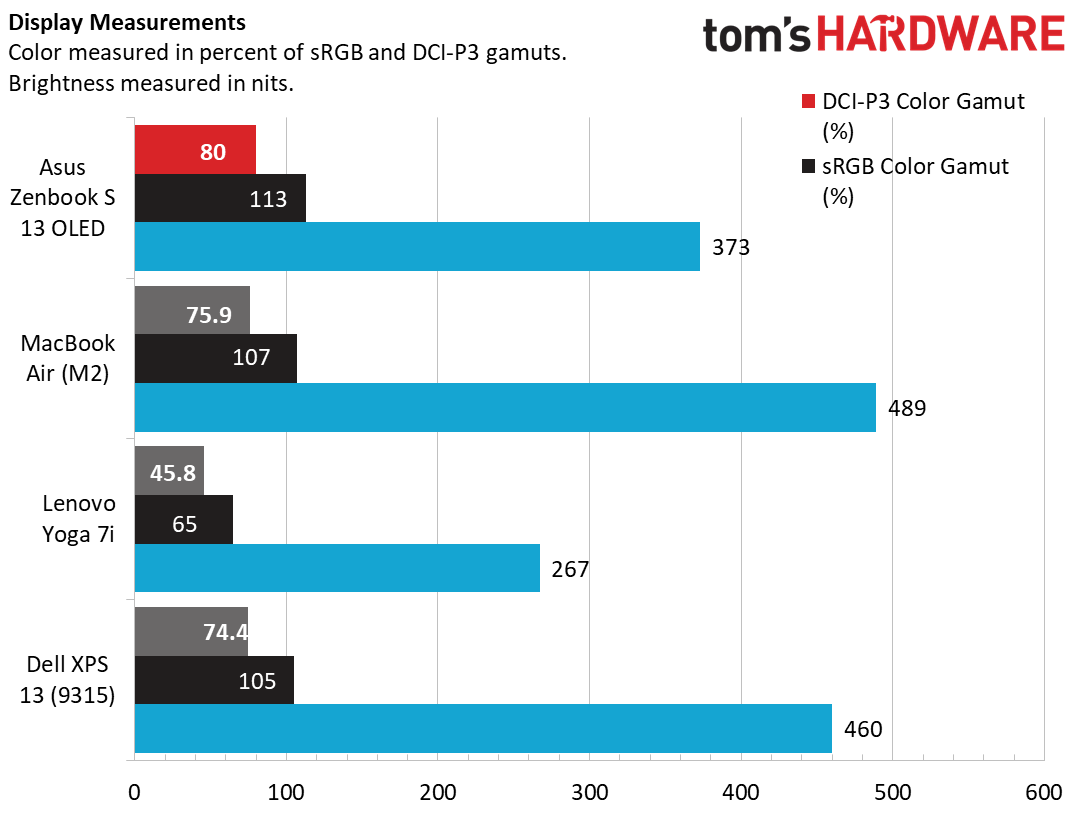
Asus' OLED panel covers 113% of the sRGB color gamut and 80% of the larger DCI-P3 space. That makes it better at color reproduction than the MacBook Air and Dell's XPS 13, and it's leagues ahead of the Lenovo Yoga 7i's panel.
Asus' screen, however, only beat the dim screen of the Yoga 7i in our testing, delivering 373 nits. The M2 MacBook Air was the leader in brightness, at 489 nits, while the XPS 13 wasn't far behind at 460.
That said, I never found myself wanting for more screen brightness when using the Zenbook S 13 – at least until the display on our first unit abruptly failed during our stress testing. Again, the second unit didn't suffer the same issue, so it's likely our first unit was defective.
Keyboard and Touchpad on the Asus Zenbook S 13
For a laptop this thin, the Zenbook S 13's keyboard feels surprisingly good. Not amazing, mind you; key travel is far from luxurious and the top row and bottom arrow keys are tiny thanks to the laptop's compact frame. But I used it to write large portions of this review and didn't have major productivity or comfort complaints.
The power button is integrated into the keyboard, which I don't generally find ideal. But its placement to the left of the delete key in the upper-right corner meant I never hit it accidentally. And even if I did, it's a bit stiffer than the regular keys around it, so I don't see it being a problem for most people.

The touchpad (which Asus feels the need to brand as ErgoSense) is also pleasant to use and pleasingly roomy at 6 inches, diagonally. It features a physical click that doesn't feel hollow or cheap. Asus says its 0.23 mm click depth is "1.44x longer than the previous model."
Given that the click here doesn't feel particularly deep, it sounds like I would not have loved the touchpad on the previous Zenbook. I had no issues with this touchpad though. Multi-touch gestures also worked well. If only I could remember to use these gestures when I'm not reviewing a laptop.
Audio on the Asus Zenbook S 13
The pair of speakers on the Zenbook S 13 are good – for a laptop that's less than half an inch thick. When I listened to IAMX's latest album, "Fault Lines," there was a decent amount of volume with the laptop turned all the way up. And even when cranked, I didn't notice any distortion in Chris Corner's alternating moans and shouty falsetto. But as is often the case with thin laptops (and plenty of not-so-thin ones, too), there wasn't much in the way of discernable bass.
The laptop comes with Dolby Atmos software, which has presets like Detailed, Balanced and Warm, as well as others for games and movies. I tried playing with them to eke out more low-end but always came back to the default Balanced setting.
In short, the sound output on the S 13 offers no major complaints for a super-slim and light laptop, but it's not the best. HP's Elite Dragonfly G3 offers louder and punchier speakers in a similar weight class. But you'll generally have to spend a lot more for that laptop. A configuration with a similar component layout as the Zenbook S 13 sells for around $2,000.
Upgradability of the Asus Zenbook S 13
Provided you have the small Torx bit that's required, getting inside the Zenbook S 13 is surprisingly easy. After removing 11 screws on the bottom of the laptop (which come in two lengths, so don't mix them up when screwing them back into the laptop), the bottom lifts off with relative ease.
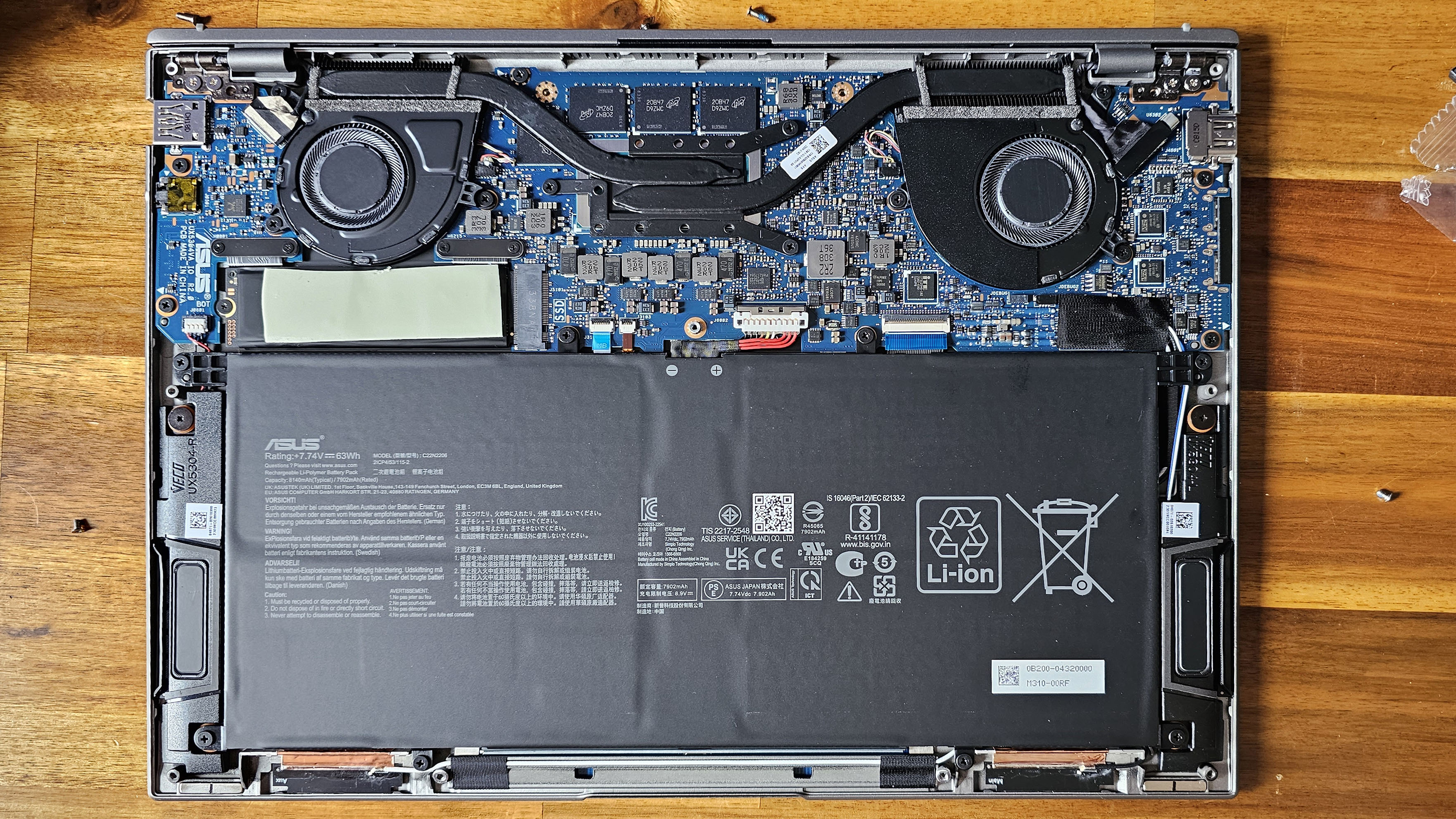
Inside the slim laptop though, there isn't much to do other than possibly upgrade the M.2 SSD that lives under a thermal pad on the left in the image above. The Micron RAM you can see up above the CPU is soldered on. And about two-thirds of the laptop's internal space is taken up by the 63 WsHr battery.
Battery Life on the Asus Zenbook S 13
I wasn't sure where the Zenbook's battery life would land, given that it's one of the thinnest laptops available and it also has a fairly high-resolution OLED display. But its showing of 10 hours and 45 minutes on our battery test (which simulates browsing the web, streams video and runs light graphics tests with the display set to 150 nits of brightness) was more than I expected.
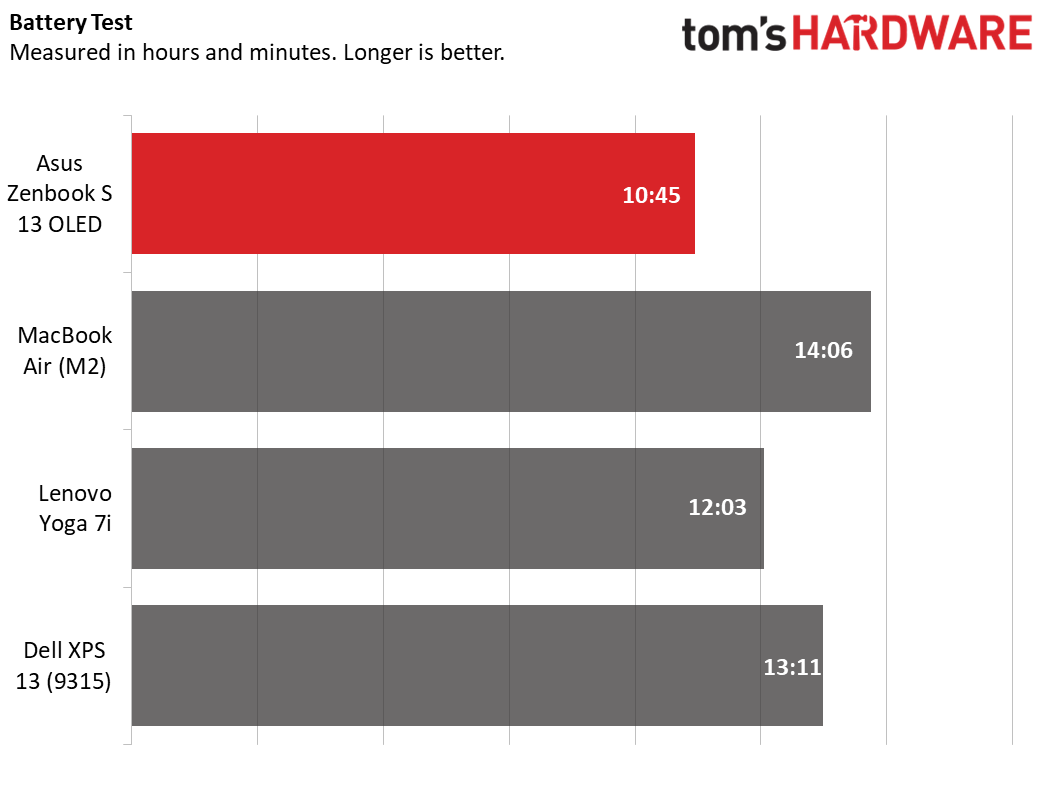
That said, that 10:45 result was more than an hour behind its closest competitor here, the Lenovo Yoga 7i, which lasted 12:03. And Apple's MacBook Air topped 14 hours on the same test. So in short, battery life on the Zenbook is solid, but behind the pack of competing ultra-light laptops.
Heat on the Asus Zenbook S 13
As is somewhat to be expected on a laptop this thin, Asus' latest Zenbook gets toasty under prolonged load. To see how hot it gets under stress, we measured the temperature while running our Cinebench R23 stress test.
During the 20-run test, the keyboard got its warmest in the area of the T, Y, and U keys (above where the CPU sits), topping out at 114.2 degrees Fahrenheit (45.67 Celsius). The touchpad stayed comparatively cool, hitting 84 degrees Fahrenheit (28.89 Celsius). The bottom of the laptop was even warmer, hitting 122.7 degrees Fahrenheit ( 50.39 Celsius). But that hot point was near the center rear, up under the rubber foot that runs the device's width. The areas around the edge and front of the laptop's bottom, where you're likely to be holding it, were much cooler.
Webcam on the Asus Zenbook S 13
You won't find any fancy high-resolution webcam on the Zenbook S 13, but the 1080p sensor that sits above the screen gets the job done without eliciting major complaints from me. There's enough resolution that I could make out the macabre detail on my Skinny Puppy shirt, and colors were accurate. Sunlight streaming in from the windows behind me while I wrote this was rendered as big washed-out blobs of white light. But that didn't affect the sharp focus on my face, so long as I had the laptop within typing distance in front of me.
There are also IR sensors for using Windows Hello, which worked well, even after the display on our unit stopped functioning. In short, this isn't the best webcam that I've seen on a laptop, but it's at least a step or two above "good enough" and should get you through out-of-office work meetings just fine.
Software and Warranty on the Asus Zenbook S 13
Aside from the screen deciding to stop working near the end of our testing, by far the worst thing about the Zenbook S 13 is how much gunk Asus pre-loads onto its premium portable. Beyond the usual Windows 11 shortcuts in the Start menu, there's a McAfee popup that keeps nagging you in the lower-right corner, Asus' GlideX app for "running mobile apps on a larger screen," ScreenXpert for moving and grouping apps across multiple screens, and the MyAsus app, which links you to customer support and customization options.
MyAsus also persistently nags you to lot into your Asus account, including on the splash page. And there's a whole section in the app called Asus Promotion, which mostly just offers trials of things like McAfee (again), NordVPN and Adobe programs, which of course are all subscription services that will start charging you (and presumably kick back some of that to Asus) if you forget to cancel.
The Edge browser is also cluttered with a collection of links to McAfee (yes, again) and the Asus Software Portal, which again features a prominent link to McAfee. It's not that most of this stuff isn't fairly easy to uninstall, but for a laptop that costs $1,400, the Zenbook S 13's out-of-the-box environment feels a lot more freemium than premium.
Bottom Line
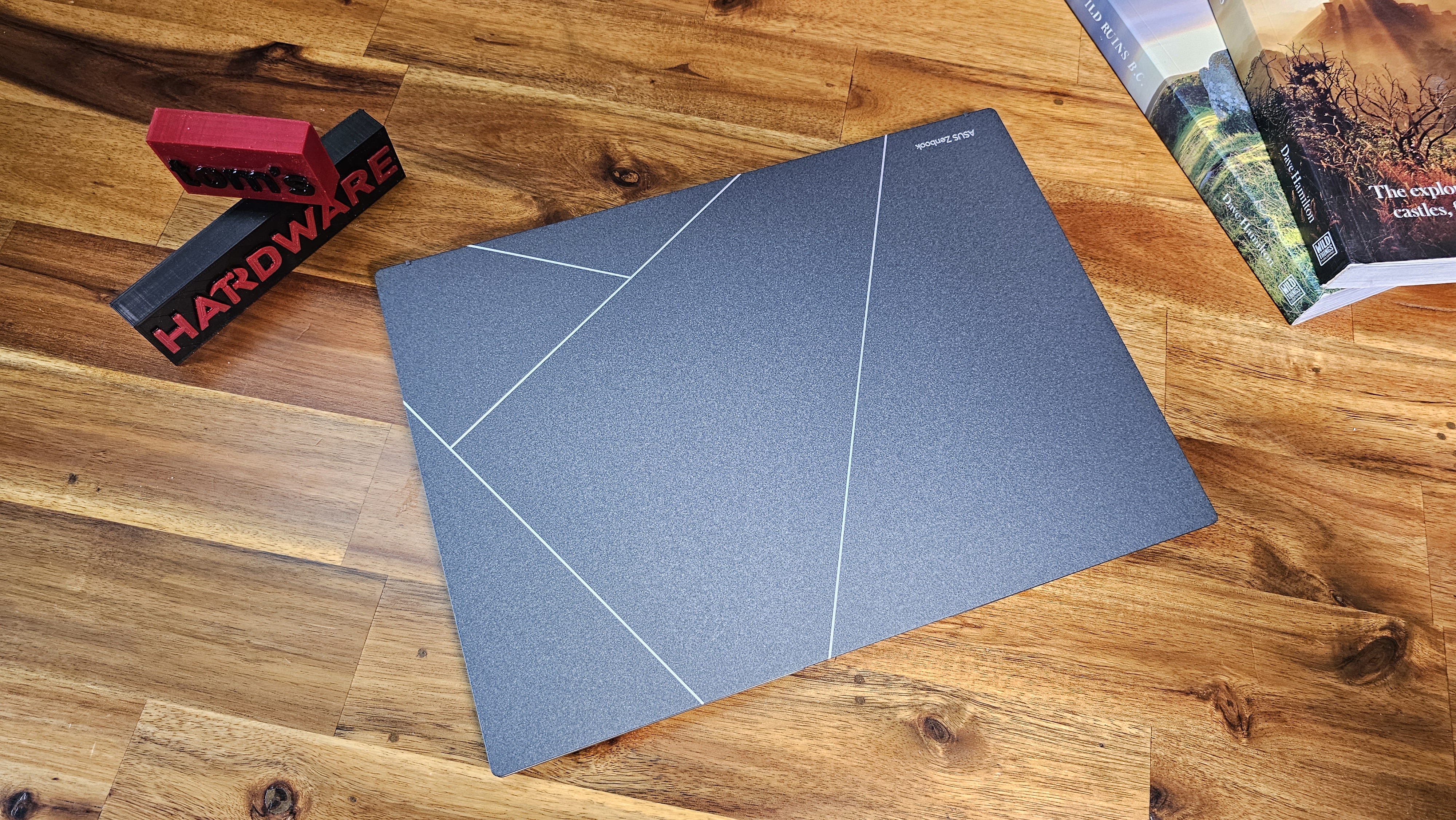
I really wanted to like the Zenbook S 13 OLED, and for bits of time while testing and writing this review, I did. The physical design is striking; the laptop at least feels premium and well-built; and the input devices, battery life, and ports don't sacrifice too much for a laptop that's among the thinnest and lightest available. Plus, I love that 32GB of RAM and a fast 1TB SSD come standard (at least in the U.S., sorry Canada). Even the price, while high for most people at $1,399, is actually quite low for those specs.
But nagging software that seems always to be trying to sell you something mars the overall experience. And the cooling that Asus was able to wedge into the laptop's skinny 0.43-inch frame isn't really up to the task of keeping the laptop's performance up during CPU-heavy tasks that take more than a few seconds. And during our half-hour Cinebench stress test, the laptop got warmer than any ultraportable we've tested lately.
If you like the Zenbook's design and need something with 32GB of RAM because you don't like closing programs or browser tasks, the Zenbook S 13 is a decent option. But if you want to actually use the RAM and the Core i7 CPU for things like video editing or other time-consuming compute tasks, while still sticking with a slim, lightweight design, also consider HP's Elite Dragonfly G3 or maybe an XPS 13. Those laptops will cost more with similar components, but their thermal design is better suited to heavier workloads.
MORE: How to Buy a Gaming Laptop
MORE: Best Gaming PCs







